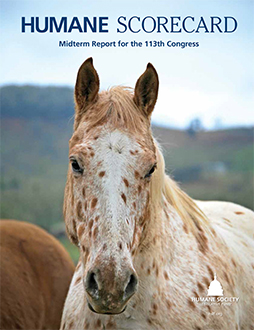 Each year, the Humane Society Legislative Fund (HSLF) publishes a Humane Scorecard of Congress to inform us of every legislator’s record on animal protection issues. We urge everyone to take time to read the recently-published Midterm Report for the 113th Congress, an invaluable resource for staying informed on animal rights legislation. With this information, we can let our lawmakers know we care about the humane treatment of animals by either thanking those who had high scores, or letting them know we are watching and expecting better results from those who scored poorly.
Each year, the Humane Society Legislative Fund (HSLF) publishes a Humane Scorecard of Congress to inform us of every legislator’s record on animal protection issues. We urge everyone to take time to read the recently-published Midterm Report for the 113th Congress, an invaluable resource for staying informed on animal rights legislation. With this information, we can let our lawmakers know we care about the humane treatment of animals by either thanking those who had high scores, or letting them know we are watching and expecting better results from those who scored poorly.
For many, the idea of reading a “report” is eye roll producing, but the HSLF Humane Scorecard is very well-organized, easy to read and to understand. Charts with Senate and House scored items tells us by state and name how our lawmakers voted.
There is a tremendous amount of GOOD NEWS in this Scorecard. Positive gains were made on several key animal protection issues, with the door open for continued progress in 2014. Below is an excerpt from Michael Markarian, HSLF president, on his blog post dated January 7, 2014:
During the first year of the session, we already had one major bill enacted that facilitates the retirement of hundreds of chimps from barren laboratories to natural sanctuaries, and laid substantial groundwork on a number of other issues—such as protecting horses from “soring” cruelty, doping, and slaughter, and fortifying the federal law against dogfighting and cockfighting—which are teed up for action in 2014. As we look back on 2013 and head into the second part of the two-year Congress, we’re poised for significant gains on several priorities.
Markarian followed with these top statistics in his blog upon the publication of the 2013 Scorecard on January 24, 2014:
- A bipartisan group of 35 Senators and 127 Representatives covering 40 states, Guam, Puerto Rico, and the District of Columbia led as prime sponsors of pro-animal legislation and/or scored a perfect 100—more than one-third of the Senate and one-quarter of the House.
- The average Senate score was a 41, with Senate Democrats averaging 64, Senate Republicans averaging 13, and Senate Independents averaging 80.
- The average House score was a 48, with House Democrats averaging 82, and House Republicans averaging 18.
- Nineteen Senators scored 100 or 100+.
- Thirty-five Senators scored zero.
- More than one-quarter of the House (119 Representatives) scored 100 or 100+.
- Eighty Representatives scored zero.
- The New England region led the pack with an average House score of 99 and an average Senate score of 87, followed closely by the West with a House score of 70 and a Senate score of 57, and the Mid-Atlantic region with a House score of 72 and a Senate score of 55.
- The Rocky Mountains and the Southeast were at the bottom with average House scores of 29 and 33, respectively, and each had an average Senate score of 18.
- California, New Jersey, Vermont, and Washington were the only states that had average Senate scores of 100.
- In Arizona, Georgia, Indiana, Nebraska, North Dakota, Texas, Utah, and Wyoming, both Senators scored zero.
- Maine, Massachusetts, New Hampshire, and Rhode Island each had a House average of 100, and Connecticut, Hawaii, New Jersey, and Vermont each had a House average of 85 or higher.
- Alaska, North Dakota, and Wyoming (each with one at-large member) were the only states with a House score of zero, while Arkansas, Idaho, Mississippi, Nebraska, Oklahoma, and Utah each had an average House score in single digits.
ABOVE-REFERENCED HSLF LINKS



